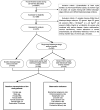Frozen-thawed double cleavage-stage or frozen-thawed single day 6 blastocyst stage embryo transfer: which is preferable for patients younger than 35 without day 5 blastocyst formation?
- PMID: 40438401
- PMCID: PMC12116357
- DOI: 10.3389/fendo.2025.1473854
Frozen-thawed double cleavage-stage or frozen-thawed single day 6 blastocyst stage embryo transfer: which is preferable for patients younger than 35 without day 5 blastocyst formation?
Abstract
Background: To compare the clinical outcomes between frozen-thawed cleavage embryo transfer and frozen-thawed day 6 blastocyst transfer in patients younger than 35 using the freeze-all strategy without day 5 blastocyst formation.
Methods: This was a retrospective observational analysis performed between January 2018 and December 2022 at the Reproductive and Genetic Specialist Hospital of the First Affiliated Hospital of Zhengzhou University. A total of 576 patients younger than 35 who used the "freeze-all strategy" but produced no day 5 blastocysts were recruited. The patients were divided into 3 groups according to the number and stage of the transferred embryos: double cleavage-stage embryos (Group A), single good-quality day 6 blastocysts (Group B) and single inferior-quality day 6 blastocysts (Group C),and several pregnancy outcomes were measured.
Results: Groups A and B exhibited significantly higher chemical (73.7%, 67.0% versus 51.9%) and clinical pregnancy rates (69.0%, 59.4% versus 44.2%) than Group C. The implantation rate was significantly higher in Group B than in Groups A and C (59.4% versus 45.7%, 43.5%). The live birth rate was significantly higher in Group A than in Group C (59.2% versus 48.1%). The multiple pregnancy rate was significantly higher in Group A than in Groups B and C (34.4% versus 1.6%, 1.5%). The early miscarriage rate was significantly higher in Group C than in Group A and Group B (23.5% versus 8.7%, 12.7%). Premature delivery rates, late miscarriage rates and ectopic pregnancy rates were comparable across groups.
Conclusions: A single good quality day 6 blastocyst transfer was the preferable strategy for the freeze-all strategy patients who younger than 35 and without day 5 blastocyst formation.
Keywords: blastocyst-stage embryo transfer; cleavage-stage embryo transfer; frozen-thawed transplantation; single embryo transfer; transfer strategy.
Copyright © 2025 Liu, Wang, Dai, Shi and Sun.
Conflict of interest statement
The authors declare that the research was conducted in the absence of any commercial or financial relationships that could be construed as a potential conflict of interest.
Figures


Similar articles
-
One fresh cleavage-stage single embryo transfer (SET) plus one frozen-thawed blastocyst-stage SET or one fresh cleavage-stage double embryo transfer? A retrospective matched cohort study.Hum Reprod. 2024 Dec 1;39(12):2702-2710. doi: 10.1093/humrep/deae245. Hum Reprod. 2024. PMID: 39487583
-
The association between pregnancy outcomes and frozen-thawed embryo transfer cycles based on D3 cell count in high-quality blastocysts.Front Endocrinol (Lausanne). 2024 Oct 18;15:1464313. doi: 10.3389/fendo.2024.1464313. eCollection 2024. Front Endocrinol (Lausanne). 2024. PMID: 39493775 Free PMC article.
-
Clinical outcomes of frozen-thawed single blastocyst transfer derived from low-quality day 3 embryos: A retrospective cohort study.Front Endocrinol (Lausanne). 2025 Jul 28;16:1583779. doi: 10.3389/fendo.2025.1583779. eCollection 2025. Front Endocrinol (Lausanne). 2025. PMID: 40791991 Free PMC article.
-
Number of embryos for transfer following in vitro fertilisation or intra-cytoplasmic sperm injection.Cochrane Database Syst Rev. 2020 Aug 21;8(8):CD003416. doi: 10.1002/14651858.CD003416.pub5. Cochrane Database Syst Rev. 2020. PMID: 32827168 Free PMC article.
-
Day 5 versus Day 6 blastocyst transfers: a systematic review and meta-analysis of clinical outcomes.Hum Reprod. 2019 Oct 2;34(10):1948-1964. doi: 10.1093/humrep/dez163. Hum Reprod. 2019. PMID: 31644803 Free PMC article.
References
-
- Sills ES, Palermo GD. Human blastocyst culture in IVF: current laboratory applications in reproductive medicine practice. Rom J Morphol Embryol. (2010) 51:441–5. - PubMed
Publication types
MeSH terms
LinkOut - more resources
Full Text Sources

